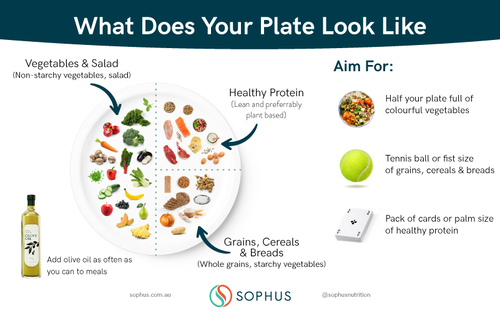Tracking Your Food
Upload images of your meals and snacks into your food diary along with optional personal notes to provide more context such as ingredients, how the meal made you feel, or if you enjoyed it! The Sophus photo food diary isn’t about numbers and reaching macro targets; it’s about finding patterns and reflecting on these to move towards making healthier choices for your goals. To help you do this, the dietitians at Sophus can see your journal posts provide you with encouragement and personalised advice.
Why keep a food diary?
A photo food diary is an effective and simple way that you can track and visualise your eating habits over time without having to record every ingredient or detail of your meal. Keeping a food diary is a helpful way that you can identify eating habits and patterns; including meal regularity, portion sizes and food variety, which all play a role in healthy eating.
By logging your meals and snacks along with your energy levels and mood in your journal, you’ll see possible relationships between how your food choices impact how you feel.
View your trends
When you add photos and notes to your food diary, you’ll be able to see a visualisation of your eating patterns in your Trends View. In your Trends view, you’ll get a snapshot of the frequency of meals that you log, as well as the time you log them. Understanding your own meal patterns is a helpful part of understanding your health.
Meal regularity has been found to be beneficial for:
Maintaining energy
Maintaining or reaching a healthy weight
Eating a nutrient-rich diet
Research has found that people who have more structured eating patterns are more likely to have planned meals that include a variety of foods like vegetables, wholegrains, fruit, lean meats and healthy fats; and are less likely to eat too many foods that are high in saturated fat, added sugars and excess energy (kilojoules/calories).
Tips for keeping a food diary
Take pictures of each of your meals, snacks and drinks to help you remember what you ate and drank
Add notes to your images to give more context like how the foods are cooked, how you’re feeling while you’re eating, and where you were eating (for example, on the go, at your desk, while watching tv etc)
If you’re the type of person who prefers to log all of meals for the day before you head to bed, you can upload all your photos at the end of the day and change the time in your food diary entry to reflect your actual meal time.
What should my meals look like?
For most of us, a well balanced meal will be:
1/2 filled with colourful veggies,
1/4 filled with wholegrains, and
1/4 filled with lean protein.
If you aim to follow what we call ‘The Plate Model’ for two meals every day, you’re on the right track to eating a well-balanced and healthy diet!
Why we don’t focus on numbers
On top of being extremely tedious, research has found that number-focused journaling can pose a risk to some people’s relationship with food and mental health.
There are some select instances where number-based tracking can be helpful or even necessary when keeping a food diary, however in majority of cases, a photo food diary is an accurate tool for estimating meal nutrients and portion sizes. In the case of the Sophus photo food diary, your Sophus dietitian will be able to get a good representation of your eating patterns through photos along - but in the case that they do need more information from you, they’ll send you a message!



